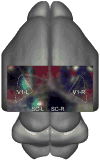Role of emergent neural activity in visual map development
- PMID: 24492092
- PMCID: PMC3957181
- DOI: 10.1016/j.conb.2013.11.011
Role of emergent neural activity in visual map development
Abstract
The initial structural and functional development of visual circuits in reptiles, birds, and mammals happens independent of sensory experience. After eye opening, visual experience further refines and elaborates circuits that are critical for normal visual function. Innate genetic programs that code for gradients of molecules provide gross positional information for developing nerve cells, yet much of the cytoarchitectural complexity and synaptogenesis of neurons depends on calcium influx, neurotransmitter release, and neural activity before the onset of vision. In fact, specific spatiotemporal patterns of neural activity, or 'retinal waves', emerge amidst the development of the earliest connections made between excitable cells in the developing eye. These patterns of spontaneous activity, which have been observed in all amniote retinae examined to date, may be an evolved adaptation for species with long gestational periods before the onset of functional vision, imparting an informational robustness and redundancy to guide development of visual maps across the nervous system. Recent experiments indicate that retinal waves play a crucial role in the development of interconnections between different parts of the visual system, suggesting that these spontaneous patterns serve as a template-matching mechanism to prepare higher-order visually associative circuits for the onset of visuomotor learning and behavior. Key questions for future studies include determining the exact sources and nature of spontaneous activity during development, characterizing the interactions between neural activity and transcriptional gene regulation, and understanding the extent of circuit connectivity governed by retinal waves within and between sensory-motor systems.
Copyright © 2013 Elsevier Ltd. All rights reserved.
Figures


References
-
- Hubel DH, Wiesel TN. Ferrier lecture. Functional architecture of macaque monkey visual cortex. Proc R Soc Lond B Biol Sci. 1977;198:1–59. - PubMed
-
- King WM, Zhou W. New ideas about binocular coordination of eye movements: is there a chameleon in the primate family tree? Anat Rec. 2000;261:153–61. - PubMed
-
- Cang J, Feldheim DA. Developmental Mechanisms of Topographic Map Formation and Alignment. Annu Rev Neurosci 2013 - PubMed
Publication types
MeSH terms
Grants and funding
LinkOut - more resources
Full Text Sources
Other Literature Sources

